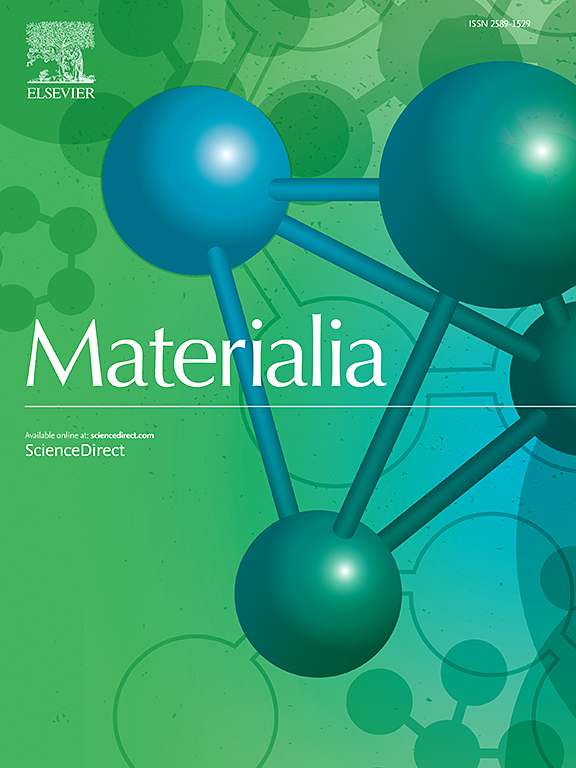钇源对1300℃时与CaO-Al2O3-SiO2熔体相互作用后析出相形貌的影响
IF 2.9
Q2 MATERIALS SCIENCE, MULTIDISCIPLINARY
引用次数: 0
摘要
在航空发动机领域,用于保护涡轮叶片的陶瓷涂层的耐用性与它们承受钙镁铝硅酸盐(即CMAS)腐蚀的能力密切相关,CMAS在高温下成为液体时可以渗透到陶瓷涂层的微观结构中。由于具有CMAS的陶瓷涂层具有高反应性,可以快速析出保护相,因此可以提供保护。大多数陶瓷涂层含有稀土元素(如稀土单硅酸盐RE2SiO5或稀土二硅酸盐RE2Si2O7),因此在与硅酸盐熔体反应后能够形成氧化磷灰石。本文建议根据稀土源的性质来研究这些析出相的形态。模型三元熔体CaO-Al2O3-SiO2在1300℃时与不同来源的钇接触:氧化物Y2O3,单硅酸盐Y2SiO5和二硅酸盐Y2Si2O7。反应性导致两相(即磷灰石Ca2Y8(SiO4)6O2和环硅酸盐Ca3Y2(Si3O9)2)的析出。使用这些简化的系统可以根据先前建立的相图建立平衡相的沉淀机制。根据钇源的不同,化学反应涉及熔体成分的局部修饰,这强烈地影响了平衡时析出相的形态。具体来说,本文表明,当从二硅酸钇开始时,熔体中SiO2的释放涉及针状磷灰石的特定微观结构,其核心含有沉淀的SiO2。本文章由计算机程序翻译,如有差异,请以英文原文为准。

Influence of the source of yttrium on the morphology of precipitated phases after interaction with a CaO-Al2O3-SiO2 melt at 1300°C
The durability of the ceramic coatings used to protect the turbine blades in the field of aeronautical engines is strongly linked to their ability to withstand corrosion by calcium-magnesium-aluminosilicates (i.e. CMAS), which can infiltrate their microstructure when liquid at high temperature. Protection can be provided thanks to the high reactivity of the ceramic coatings with CMAS leading to the fast precipitation of protective phases. Most ceramic coatings contain rare-earth elements (e.g. rare-earth monosilicates RE2SiO5 or rare-earth disilicates RE2Si2O7), making them thus able to form oxyapatite after reaction with the silicate melts. The present works proposes to study the morphology of these precipitated phases depending on the nature of the rare-earth source. A model ternary melt CaO-Al2O3-SiO2 has thus been put in contact at 1300 °C with different sources of yttrium: oxide Y2O3, monosilicate Y2SiO5 and disilicate Y2Si2O7. The reactivity led to the precipitation of the two phases of interest (i.e. apatite Ca2Y8(SiO4)6O2 and cyclosilicate Ca3Y2(Si3O9)2). The use of these simplified systems allows to establish the precipitation mechanisms of the phases at equilibrium regarding previously established phase diagrams. Depending on the yttrium source, the chemical reactions involved local modifications of the melt composition, which strongly influenced the morphology of the precipitated phases at equilibrium. Specifically, it is demonstrated here that the release of SiO2 in the melt when starting from yttrium disilicate involves a specific microstructure of the acicular apatite, which exhibits a core containing precipitated SiO2.
求助全文
通过发布文献求助,成功后即可免费获取论文全文。
去求助
来源期刊

Materialia
MATERIALS SCIENCE, MULTIDISCIPLINARY-
CiteScore
6.40
自引率
2.90%
发文量
345
审稿时长
36 days
期刊介绍:
Materialia is a multidisciplinary journal of materials science and engineering that publishes original peer-reviewed research articles. Articles in Materialia advance the understanding of the relationship between processing, structure, property, and function of materials.
Materialia publishes full-length research articles, review articles, and letters (short communications). In addition to receiving direct submissions, Materialia also accepts transfers from Acta Materialia, Inc. partner journals. Materialia offers authors the choice to publish on an open access model (with author fee), or on a subscription model (with no author fee).
 求助内容:
求助内容: 应助结果提醒方式:
应助结果提醒方式:


